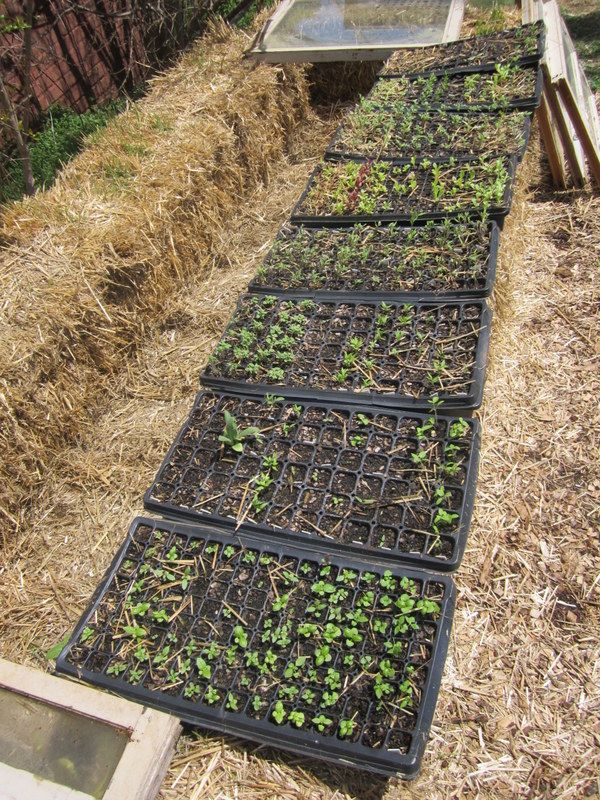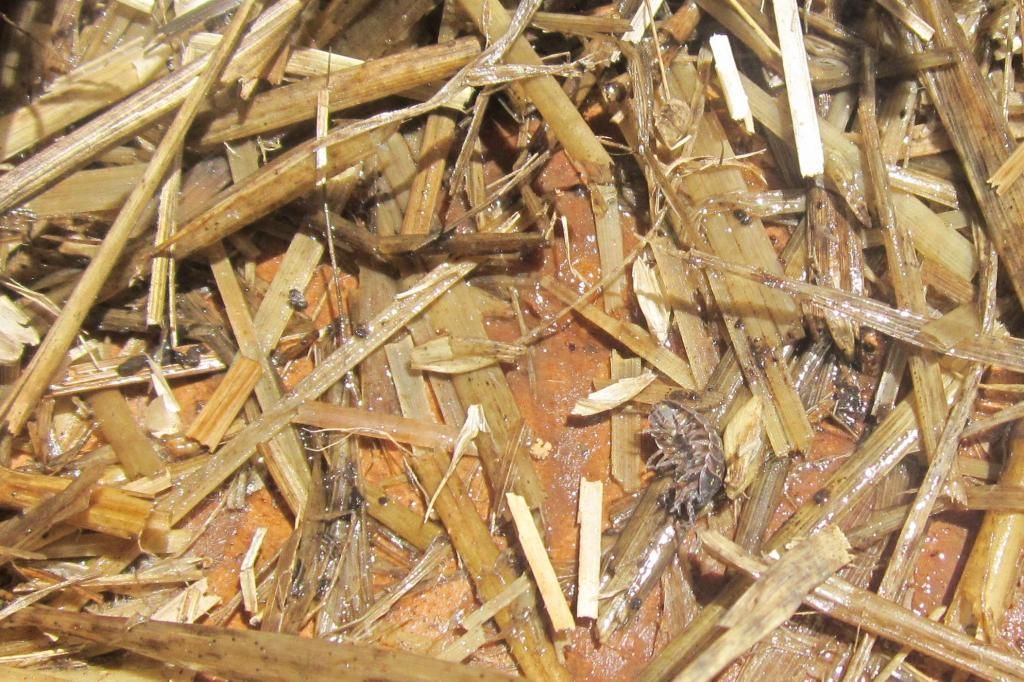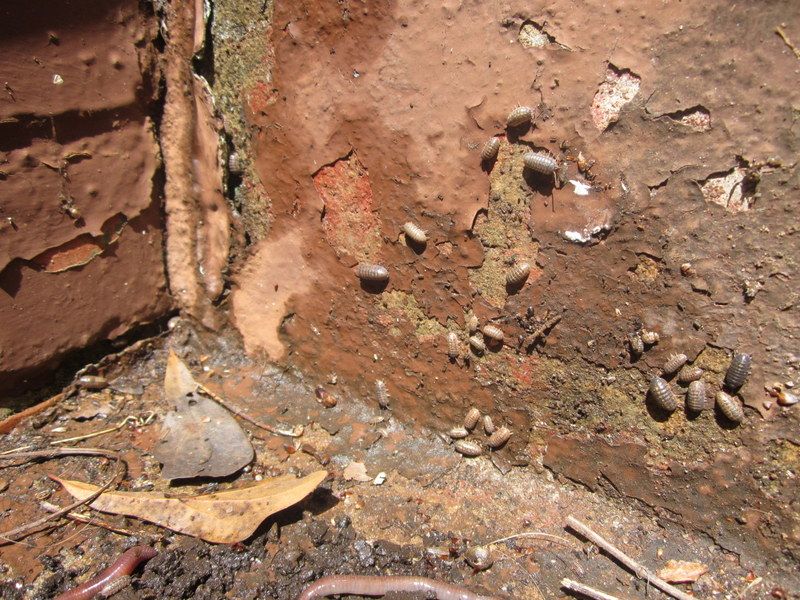How to Deal with Pillbugs When They Become a Problem
The key here is “when they become a problem.” In general, pillbugs, or roly polies as I grew up calling them, are quite nice little composters.
The textbook “fact” is that pillbugs prefer to eat rotting organic matter and only graduate to other foods when they can’t find enough. That’s actually false. They’re opportunistic omnivores, and they’re going to eat the most nutritious thing available. In addition to rotting vegetation, their favorite foods include tender plant growth, fine roots, soft fruits, moist tubers, and new seedlings. In small numbers you’re unlikely to notice when a pillbug has taken a nibble, but when they overpopulate it turns into a major issue.
This morning I went to water the seed trays in our straw bale cold frame and discovered many of the trays were missing plants. Some of the seedlings were teetering on nearly severed stems, but others were toppled or missing outright. People dealing with this problem are often told they are incorrect in their diagnosis. Before anyone suggests alternative culprits like cutworms or slugs, let me emphasize that I am pretty good at identifying pests and have obtained proof on countless occasions that pillbugs are in fact, whodunnit.
If you need further assurance that they aren’t always friendly denizens of the compost heap, here are other sources describing their destructive abilities:
- University of Idaho — pillbug and sowbug damage
- University of Nebraska — pillbugs damaging soybean seedlings
- Kansas State University — pillbugs as pests
- Texas A&M — pillbugs as pests
- University of Missouri — pillbugs as pests
- University of California — pillbugs as pests
- GardenWeb forums — pillbugs burrowing in strawberries
- GardenWeb forums — more problems with pillbugs

Photo Caption: After I discovered pillbugs munching in my seed trays, I removed the critters I could find and lifted the trays to higher ground and brighter sunlight.
The problem is, a lot of the advice that people give simply isn’t accurate or effective. Popular word-of-mouth solutions aren’t necessarily based on personal experience. Additionally, gardeners are usually poor scientists. They try something and if it works, they think it fixed their problem. The reality is that it could have been brought about by other means the gardener didn’t notice.
We really need some brainstorming to solve this issue for organic and permaculture growers!
Here’s what I know for sure about pillbugs:
- They’re neat! As crustaceans, they’re more closely related to shrimp than insects. They breathe through gills and need moisture to survive. Also, their scientific family is Armadillidiidae, which is pretty adorable.
- Their favorite conditions are identical to the favorite conditions of most plants. They’re also able to burrow to find moisture and do not leave a garden entirely during brief droughts. Once irrigation occurs, they’re back. In order to completely remove them from an environment, you’d need to create a desert situation.
- Diatomaceous earth isn’t effective in moist conditions. Also, I have witnessed pillbugs nesting in it.
- Free-range chickens are only temporarily excited to eat pillbugs when they are abundant. My brown leghorns will still eat them half-heartedly, but my other two breeds turn up their beaks. In two years of owning chickens I have noticed no reduction in the pillbug population, even when the poultry fence was broken and they had months of unrestricted access to the entire yard.
- They seem to be active year-round in my climate.
- They do like mulch, but so do plants and the rest of the soil food web. Also, even when I let a seedling bed bake in the sun the pillbugs come out from nearby hiding areas at night.
- They don’t like bright light.
- They drown easily and it appears to occur evenly whether you use water or beer.
- They will collect in rolled up moist cardboard or upturned grapefruit rinds the same way that slugs do. They often nest just under the soil next to plants they like to consume.
- They seem to cause regional problems. I know of multiple farms and gardens in the upstate of South Carolina with this predicament, but have yet to find a grower in North Carolina experiencing the same issues. People who do not have this problem look at you like you’re nuts when you bring it up.
- There must be an environmental factor that keeps their numbers under control if there are regions of the country where they aren’t a problem. We just have to figure it out.

Photo Caption: I moved the straw mulch inside the cold frame and found pillbugs nesting in the wet spots.
One thing I would like to try, but do not currently have the means to do so, are ducks. Does anyone have experience using them for this purpose?
Regarding the infestation in my seed trays: I pulled them out of the bottom of the cold frame and balanced them on the straw bales. My reasoning is that the bright light exposure from all sides will drive the pillbugs off of the seedlings. I’m also considering water traps tucked inside the frame to cause drowning.
Consider this an open discussion. What would you do? Is there anything you’ve tried and did it work? No idea is too stupid, we could really use your help!
*Update: my husband’s first suggestion is that we eat them. Any suggestions on how to harvest them easily?* 😉
13 thoughts on “How to Deal with Pillbugs When They Become a Problem”
Comments are closed.


Curbstone Valley Farm - April 12, 2013 11:56 pm
I’ve only used ducks for snail and slug control, and I must admit, it was fun to have ducks around. They learn to follow you around the garden if they think you’re rustling up treats for them! I can’t get my chickens to eat these bugs though, as they seem far more interested in worms, or caterpillars. I had a moderate problem with them last year in the strawberry beds, hiding under the straw mulch, but they don’t seem to be a problem every year here for some reason. I just haven’t come up with a great way of dealing with them yet
Curbstone Valley Farm´s last blog post ..New Additions: White Zedoary
Eliza Lord
Twitter: appalachianfeet
- June 3, 2013 6:05 pm
They do seem to like our strawberries best of all! (Leaves + fruit)
Eliza Lord´s last blog post ..How to Read Eliza’s Edible Upcountry Article & More
Donna - April 13, 2013 8:52 pm
I never had this problem with pillbugs like this, so I can offer no help. We get them, but not in numbers. Ducks sounds like a great idea. I remember a friend had one as a pet and it was so easy to take care of. It followed us everywhere too.
Donna´s last blog post ..7. The Best Gardening Advice – Yep, One on Plants
Eliza Lord
Twitter: appalachianfeet
- June 3, 2013 6:16 pm
I’m getting very tempted by ducks… maybe we can add them next season when I have fewer things on my “todo” list.
Janet, The Queen of Seaford - April 24, 2013 10:48 pm
I think the pillbugs might be on the menu for guinea hens. Word is that they eat a lot of insect pests. No research was done for this answer.. 😉
Janet, The Queen of Seaford´s last blog post ..Wildflowers – Some Found, Some Purchased
Eliza Lord
Twitter: appalachianfeet
- June 3, 2013 6:16 pm
Ooh, good idea! Although they are supposed to be pretty noisy so I might not be able to get them in the city.
Amy - May 8, 2013 6:27 pm
I’m in Asheville and I have a ton of them. Wherever I turn over earth – there they are! We just (last year) terraced the backyard to raw clay and laid mulch for the winter, so none were there yet. But this spring I brought in mushroom mulch and peat-moss. I went out yesterday to check seedlings and there they were, under the new mulch!
Eliza Lord
Twitter: appalachianfeet
- June 3, 2013 6:21 pm
Can you tell if they are eating anything? I wonder if the difference between pesky pillbugs and pleasant pillbugs has to do with temperature/hardiness zones.
Flour Sack Mama - May 17, 2013 8:27 pm
Oh no! I just meticulously sprinkled diatomaceous earth around our strawberries, and now a thunderstorm is moving in to render that useless. I’m incredibly frustrated that these guys are feasting on every barely ripe berry before we get to it. I want to try landscaping fabric around the strawberry plants so the berries don’t have a chance to touch the soil (I don’t really want them to cook in the daytime atop plastic).
Flour Sack Mama´s last blog post ..How Do You Spell The Name of That Blog?
Eliza Lord
Twitter: appalachianfeet
- June 3, 2013 1:22 pm
They are eating the leaves of my new musk strawberries (among many, many other things). I have no idea how to balance these guys naturally, yet.
Flour Sack Mama - June 4, 2013 12:21 pm
A scientist friend who’s also into organics uses crushed eggshells to deter the critters. I added those to the strawberry patch and they seemed to help. I also think the diluted neem oil I’ve sprayed around deters them somewhat.
Flour Sack Mama´s last blog post ..Rediscovering Wilderness in the American Southeast
Holly - May 14, 2014 1:18 pm
yesterday I noticed holes in my watermelon plant leaves. I guessed slugs were the problem even though I have seen none, I added crushed eggshells around my two plants. Today, when I watered my 2 plants, I saw about 20 pillbugs around them. Or maybe sowbugs, I don’t know. It really looks like they are the culprit, but eggshells did not seem to help.
Pingback: News: Eliza on TV, Upcoming Events, and Our Favorite “How To” Articles | Appalachian Feet